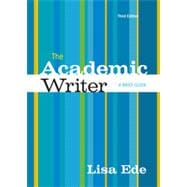PACKAGE THIS TITLE WITH OUR 2016 MLA SUPPLEMENT, Documenting Sources in MLA Style (package ISBN-13: 9781319084417). Get the most recent updates on MLA citation in a convenient, 40-page resource based on The MLA Handbook, 8th Edition, with plenty of models. Browse our catalog or contact your representative for a full listing of updated titles and packages, or to request a custom ISBN.
Written in Lisa Ede's accessible, supportive style, The Academic Writer is an affordable, brief guide to the essentials of academic writing and research. By framing reading and writing situations in terms of the writer, reader, text, and medium, Ede helps students think rhetorically and make effective choices. The text provides abundant coverage of reading, including a new chapter—"Reading on Page and Screen"—that helps students match device to purpose, and a second chapter of strategies for active and critical reading. It emphasizes analysis and synthesis, key skills required to master the moves of academic writing. And it provides advice on writing in the disciplines as well as numerous student models. With its updated coverage of research and its attention to visuals and design, The Academic Writer is the perfect introduction to college writing—at a great price.








